如何创建和管理班级
When you log in and navigate to the Classrooms page, the first thing you see is the group name or a drop-down list of all of the groups you are managing.
NOTE: Only users with the website role Group Leader / School Instructor can access this page
Group Information
On the Classrooms page, below the group heading and drop down list, you will see an indicator of seats remaining and total seats for the group you have currently selected, and a list of links to the courses associated with that Group. As groups change over time (seats are added, courses are added to groups, etc.) this information will be updated for quick reference.
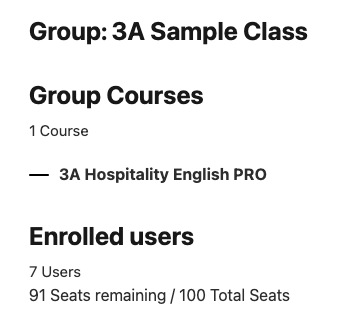
Group Users
The next section of the page is the Enrolled Users list that contains two menus for the main management functions that are available to Group Leaders. The Enrolled Users list is the current list of your group users, their email addresses, their status, and their enrollment key (more about keys and user status below). This table is simplified slightly for Basic Groups, as user management features are not available.
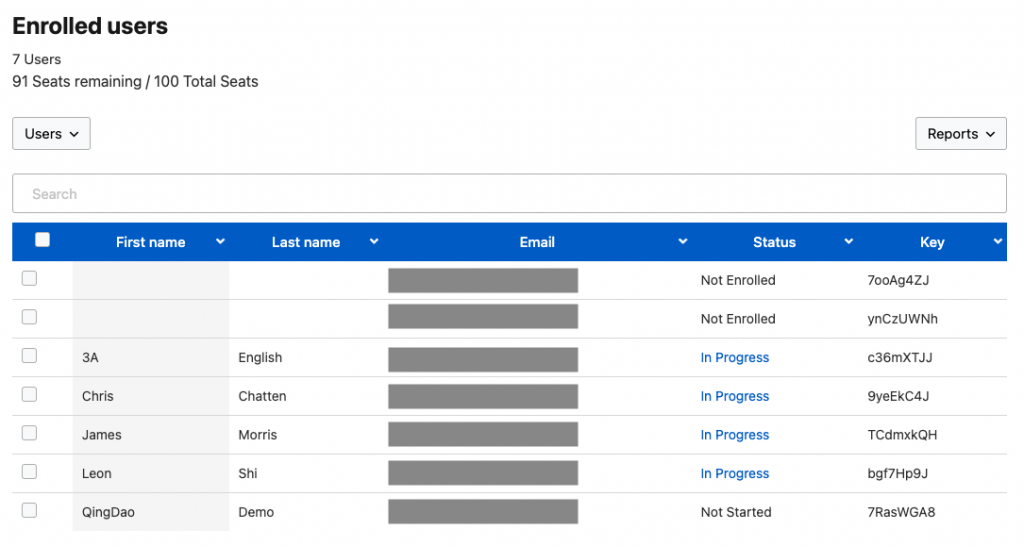
Group Leaders can click a user’s name to bring up the Edit User dialog.
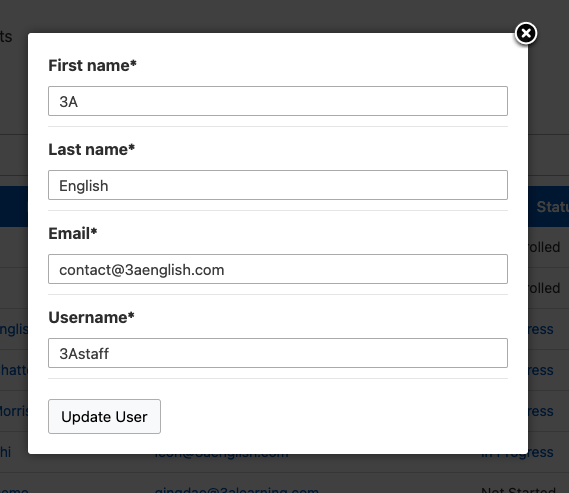
Managing Users
The following options are not available for Basic Groups. Basic Groups have access to reporting functions only.
Adding Users to Groups
When you click the Users menu, you can choose between adding one user or adding multiple users. If you select Add one, a form appears with two options:
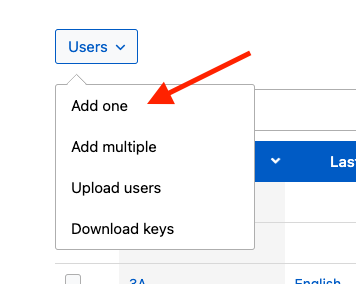
- Add and invite user: Enter the user’s first name, last name, and email address to add them to a group. Once you click the Add User button, an email is sent to the user based on the email message settings set up by your administrator. The user is added to the list of users in the group and they take up a seat in your group, and their status is set to Not Started. If you add a user that already exists on the site, the system will automatically assign a key, add them to the group and send the Add and invite (existing user) email. They then occupy a seat in the group just like a new user.
- Send enrollment key: Enter the user’s first name, last name, and email address to send them the Send enrollment key email. Once that user registers and redeems that key, they take up a seat in the group, are enrolled in the group and can begin group courses.
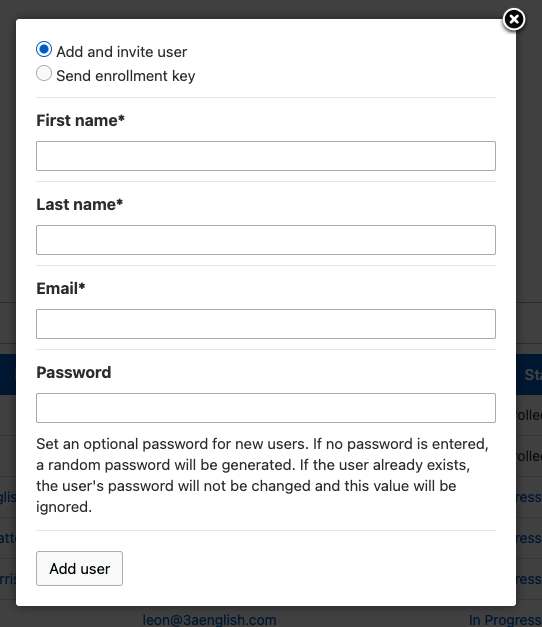
Setting a password here does allow users without a valid email address to be created. Simply use a placeholder email address and password and this account information can be provided to a student to sign in.
Removing Users from Groups
To remove users from a group, select the users you would like to remove from the Enrolled User list, and a Remove User(s) button will appear. Click on the Remove User(s) button. You will be prompted to confirm your action.
Depending on the options set by your site administrator, you may only be able to remove group members before they have enrolled and begun their courses. Once a learner has begun completing the courses that are available in the group, or if they have completed all of the courses and their status is set to Completed, it may no longer be possible to remove them from the group.
Resetting User Passwords
To generate WordPress password reset emails for users that may have forgotten their passwords, select the user(s) from the list, and a Send password reset button will appear. Click Send password reset and the user will be emailed a link to reset their password.
Adding Users in Bulk
Users can be added in bulk by clicking Users > Add multiple, or by clicking Users > Upload Users and uploading a CSV file.
The Upload Users form has options similar to those described above, with one major difference. When uploading a CSV file, you can choose not send an email to the list of users you are uploading. You might want to do this if you plan to distribute enrollment keys to your users some other way. It is helpful to download the sample .csv file to add your own user information.
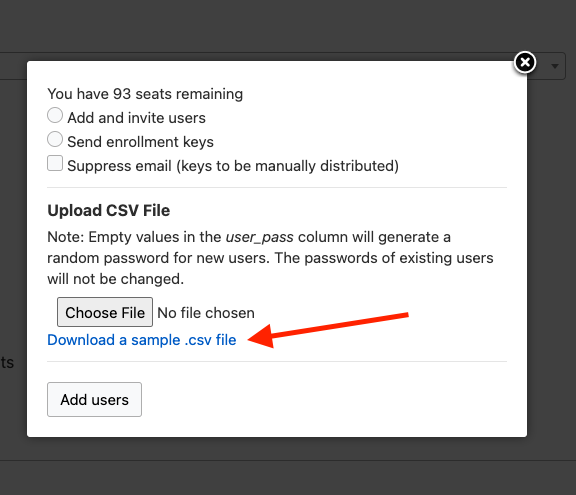
For the bulk upload to work properly, a CSV file formatted with the following column order and headings must be used: user_email; user_pass; first_name; last_name. CSV files that have incorrect formatting of email addresses, column names, etc will not be uploaded. You can download a sample file from the menu. If the user_pass cells are blank, a random password will be used, but the column heading should still be included. A column for “username” can optionally be included as the first column but is not required; if it exists but is left blank, username will default to the email address (NOTE: Some may find this a privacy issue).
If you click Users > Add multiple, the Bulk Add & Invite Users form appears.
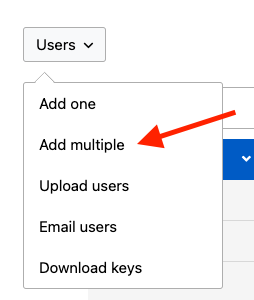
Users added to this form will receive an email based on the email message settings set up by your administrator. The users are added to the list of users in the group and they take up a seat in your group, and their status is set to Not Started.
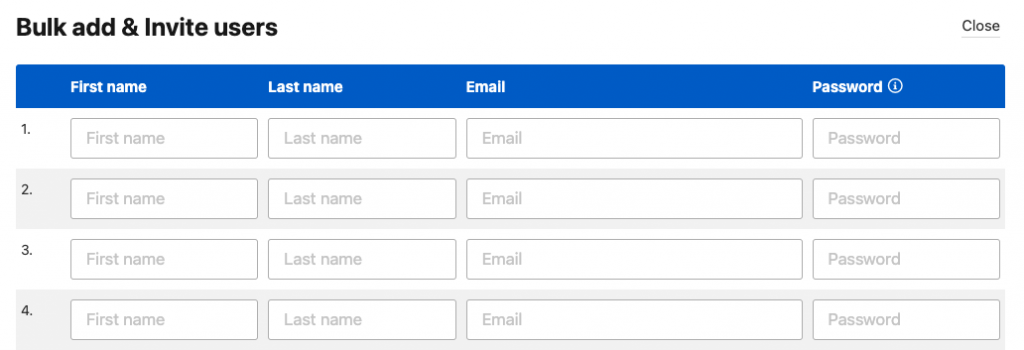
Downloading Group Keys
To download a full list of enrollment keys to be used for manual tracking, reporting, and distribution, simply click Users > Download Keys (see Fig. 2 above) and you will begin downloading a CSV file. This list is the current list of unassigned keys for that group. This list is updated when the number of seats is initially set for the group and when additional users and seats are added or removed from the Group.
Emailing Group Members
Group Leader can easily email all members of their group based on their course status (Not enrolled, Not started, In progress and/or Completed). Clicking Users > Email Users brings up the email group members interface.
Emails sent via this interface use the Group Leader’s name as the From Name, the Group Leader’s email address as the Reply-to Email, and the From address is from our server email. This is to reduce the likelihood that the emails are flagged as spam. Members are sent the email via BCC, so group members will not see each others’ email addresses.
Adding Additional Group Leaders
The lower section of the Group Management page is your Group Leaders list, and this list also has buttons located above it for adding, or sometimes removing, Group Leaders. Similar to the Enrolled Users list, the Group Leaders list displays the current Group Leaders by first name, last name, and email (see Fig. 5).
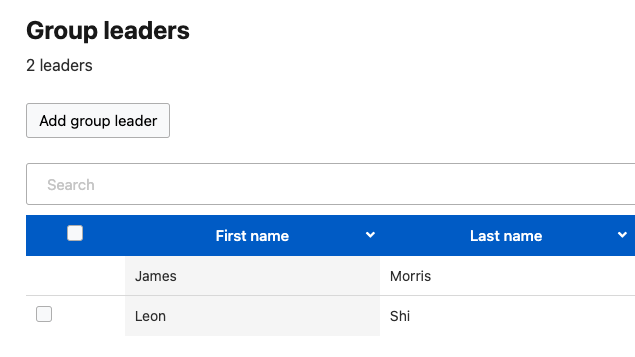
Click the Add Group Leader button. Fill out the first name, last name, and email address of the person you would like to add. If you enter the email address of an existing user, the form will not alter the First Name and Last Name fields of that user, but will add them as a Group Leader, and send them a welcome email. If the user you added as Group Leader is new, they will be sent an email welcoming them to the site and the Group.
Removing Group Leaders
To remove a Group Leader, select the users you would like to remove [1] from the Group Leaders list, and [2] a Remove Group Leaders(s) button will appear. Click on the Remove Group Leaders(s) button. You will be prompted to confirm your action.
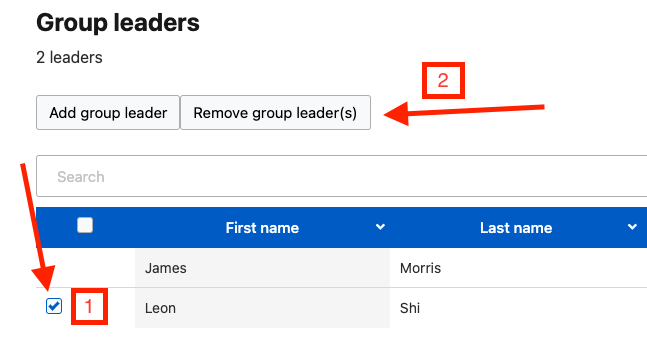
Group Leaders cannot remove themselves from the Group Leaders list. This must be done by another Group Leader.
Users, Seats, and Enrollment Keys
In order to track and manage your groups, as a Group Leader, it is important to consider the various ways that the status of a user, group seats, and enrollment keys change as users and Group Leaders are added and removed, and relative to the progress of users through group courses.
When PRO groups are created, it generates an enrollment key for each seat that is set for a group. In addition to that, each enrollment key that gets assigned or newly generated by adding seats, is a unique, one-time key. Whenever a new user or a new Group Leader is added to a group by sending them an enrollment key, they are expected to trigger their enrollment by redeeming the key. Once they do their status is changed from Not Enrolled to Not Started. Once they begin a course, their status is changed to In Progress.
In every case, when users or Group Leaders are added to groups, with or without using an enrollment key on the front end, a seat and key are automatically taken for each user and that seat remains occupied regardless of their enrollment and course completion status.
For example, if you create a group with 15 seats and assigns you as a Group Leader, you are assigned an enrollment code in the background and you occupy 1 seat in that group. When you log in and look at your group via the Classrooms Page, you will see that the remaining seats in your Group are now 14. As an existing user, you will already be enrolled and have secured a seat in the Group and your status will be set to Not Started.
Please take a close look at the following table that outlines user status and the status of enrollment keys.
| GROUP MEMBER STATUS | DESCRIPTION | REDEMPTION KEY STATUS |
|---|---|---|
| Not Enrolled | An enrollment code was sent to the specified email address. | Available |
| Not Started | The user has enrolled but not yet started any courses | Available |
| In Progress | The user has started at least one of the group’s courses | Used |
| Completed | The user has completed all courses assigned to the group | Used |